For Italian version please scroll down

Santa Maria delle Grazie, Neapel
Foto: Ciro Maietta
I remember a time of my life, when I was still living in Naples, during which, if I was not able to attend my dance classes, I would organise to go jogging with a friend.
Already dressed in shorts and a windproof jacket , which I used to protect myself from the sweat on the way back, I went by to pick up Emanuele with the Vespa.
After crossing the center, the National Archaeological Museum, the bridge of the „sanità“ with the view over the picturesque rooves of the „sgarrupati“ buildings of the famous working class neighbourhood and over the rounded domes of the churches, after having climbed the slopes of Capodimonte, with the majestic Santa Maria delle Grazie church and with the trees that in summer are filled with oranges, we finally reached the forest of Capodimonte.

Museo di Capodimonte, Neapel
Foto: Ciro Maietta
The forest is a huge park made for hunting, with picturesque views of the city, surrounding what until 1957 was a Royal Palace, which had earlier beeng the residence of the Borboni, later on of the Bonaparte and Murat dynasties during the French decade, and at the end of the Savoia family.
After 1957 the Palace became a museum, known for:
– the Farnese collection, where I cannot avoid mentioning La Flagellazione by Caravaggio – my favourite;
– an example from the Vesuvius series by Andy Warhol;
– the precious pottery, including an entire living room that consists of about 3,000 porcelain pieces (including the walls) for Queen Amalia.
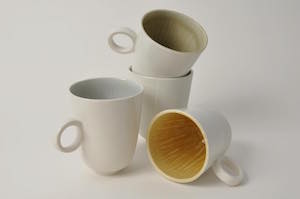
Lucio Campoli Ceramche
During our jogs, I got to learn more about these places and their history.
I was able to find out about some of the buildings in the park. I wasn’t always able to find out the current purpose or their original one, but with some of them I did…
One morning, as we were running, we passed a gang of kids who were coming out from a yellow building to the side of one of the avenues of Oaks that fan out from the park in front of the Royal Palace. My friend Emanuele told me that they were students of a school set up to pass on the traditional craft of ceramics which began centuries ago when King Carlo di Borbone and his wife Maria Amalia di Sassonia founded the Royal Porcelain Factory of Capodimonte.
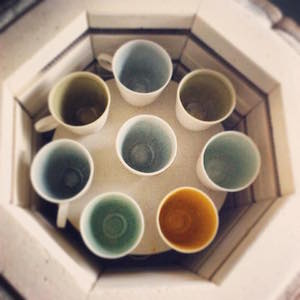
Lucio Campoli Ceramche
I already knew that Capodimonte porcelain was valuable and soughtafter. At my parents‘ house there are some sophisticated sculptures that I remember from always. Some of them, when I was little, were on display in the living room at my grandparents‘ house. What I did not know was the origin and history of the „earth’s vase.“
An artist craftsman from Rome
It was here in Berlin that I learned many more things about ceramics.
It was remarkable to learn that, in Europe, the first to discover the composition of the precious Chinese porcelain (which is obtained by melting granules of kaolin and feldspar), was a German named Johann Friedrich Böttger.
It is thanks to his discovery that in 1710 the German Meissen factory was founded. The Capodimonte porcelain – born shortly after – is in fact different from the Northern European ceramic. Seeing as there were no kaolin mines in the South, the dough is done by merging various clays, which originate from Southern Italy, with the feldspar. The result is a white malleable dough, which makes the Capodimonte porcelain unique.
The person who then taught me everything there is to know was the artist craftsman from Rome, Lucio Campoli.
Lucio’s education started in Italy, first at the Art Institute of Ceramics in Faenza Gubbio and then at the Art Institute G. Ballardini.
After working as an assistant at some of the most important pottery studios in Milan, Rome and Bologna, Lucio moved to Berlin, where he opened his own studio.This summer I went to see his exhibition here in Berlin. I already knew some of his pieces from previous collections and from the very first time I had seen his work, I was won over by the geometry of his products; from the clean lines of the pots and glasses to the bright colors of his jewellery, all of which had an original design. The handles of the pitchers and cups also struck me for their form (sometimes they were square rings) and for being applied at unusual heights, so as to give each piece an unusual silhouette. The choice to leave some parts raw and others lacquered, the vivid colors used for the plates and to brighten up the inside of the glasses and white cups, made his creations elegant and modern.
In short, it was very difficult to resist my temptation to buy them all! This time, the event was dedicated to the presentation of the Flüc line; the result of a successful collaboration with a Mexican potter called Floricia Calderon. In this case, seeing the exclusive and limited production of porcelain on display, it was evident that the different inspiration had led to two series of work, which were both very interesting and conceived with great taste.
A line of the collection was made up of vases with the curves that echoed forms of Mexican vegetation. Another line consisted of sets of variously shaped cups of different sizes with a clearly oriental decoration. Even in this new venture, Lucio’s style was recognizable.
In Berlin, it’s a very different story
During the show, in addition to all of the information on ceramics and on his work I did not miss the opportunity to investigate and ask Lucio his reasons for choosing to live in Berlin.
He explained to me that, although it wasn’t the only reason for him to move here, his job was one of the main reasons for his decision.
Lucio told me that here it is easier to find materials to work with at higher temperatures (something fundamental for his work), and that ceramic is more well known and used here than it is in Italy, where the production sites are still linked to the antique decor of the 1400s. But the basic reason is that here a craftsman can live more decently; not only in the economic sense, but it’s also a question of mentality. In Italy, being artist is often regarded as a mask to disguise doing nothing, or maybe you are rich and famous, or perhaps you are like the large number of people who devote themselves passionately to music, painting or any other art form, but lack any type of recognition and respect even. Here in Berlin, it’s a very different story…
As I imagined, the Flüc collection received the success it deserved and sold out. Now, at my parents‘ house in Naples, as well as the Capodimonte porcelain, you can admire Lucio Campoli’s own creations in porcelain.
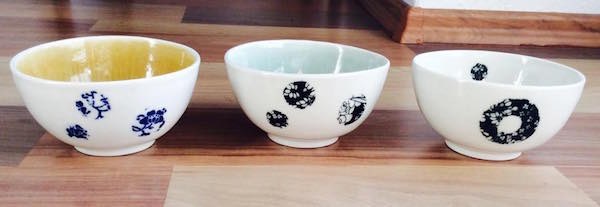
Seria Flüc – Floricia Calderon Lucio Campoli
Italian Version

Santa Maria delle Grazie, Neapel
Foto: Ciro Maietta
Ricordo un periodo della mia vita, quando vivevo ancora a Napoli, in cui se non riuscivo ad andare a danza, mi organizzavo con un amico per andare a correre.Direttamente vestito con pantaloncini cortissimi e con una giacchetta anti vento, da usare al ritorno per proteggermi dal sudore, passavo a prendere Emanuele con la Vespa.

Museo di Capodimonte, Neapel
Foto: Ciro Maietta
Dopo aver attraversato il centro, il Museo Archeologico Nazionale, il ponte della Sanità con la pittoresca vista sui tetti dei palazzi “sgarrupati” del famoso quartiere popolare e sulle tondeggianti cupole delle chiese, dopo esserci inerpicati per le salite di Capodimonte, con la maestosa chiesa di Santa Maria delle Grazie e con gli alberi che d’estate si riempiono di arance ai lati dei marciapiedi, raggiungevamo, finalmente, il bosco di Capodimonte.
Il bosco è un grandissimo parco realizzato per la caccia, con suggestivi scorci panoramici sulla città, che circonda quello che fino al 1957 era un palazzo reale, residenza prima dei Borbone, durante il decennio francese, dei Bonaparte e Murat e poi dei Savoia.
Dopo il 1957 la Reggia è divenuta un museo, famoso soprattutto per:
– la collezione Farnese, tra le cui opere non posso non citare La Flagellazione di Caravaggio, la mia preferita;
– un esemplare della serie Vesuvius di Andy Warhol;
– le preziose ceramiche, tra cui un intero salotto composto da circa 3000 pezzi in porcellana (pareti comprese) per la regina Amalia.
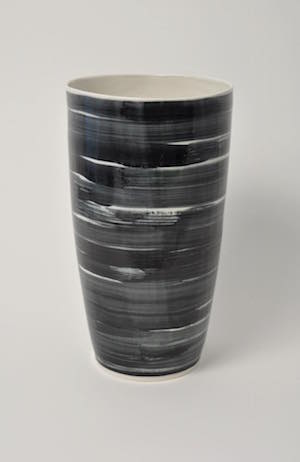
Lucio Campoli Ceramche
Durante il nostro jogging, ho avuto modo di conoscere meglio quei luoghi e la loro storia.
Di alcuni edifici o anche di piccole costruzioni che si possono incontrare nel parco, non sempre sono riuscito a sapere l’attuale destinazione o quella originaria, ma di altre si…
Una mattina, mentre correvamo, siamo passati davanti a una ciurma di ragazzi che uscivano da un edificio giallo al lato di uno dei viali di lecci che si aprono a raggiera dal parco antistante la Reggia. Il mio amico Emanuele mi ha spiegato che si trattava degli studenti di una scuola superiore istituita per tramandare la tradizione artigianale della ceramica iniziata secoli prima, quando il re Carlo di Borbone e sua moglie Maria Amalia di Sassonia fondarono la Real Fabbrica di Porcellana di Capodimonte.
Già sapevo che la porcellana di Capodimonte era preziosa e ricercata. A casa dei miei genitori ci sono alcune raffinatissime sculture che ricordo da sempre. Alcune di queste, quand’ero piccolo, erano in bella mostra nel salotto di casa dei miei nonni.
Quello che non conoscevo era l’origine e la storia della “terra da vasaio”.
Un artista artigiano di Roma
È stato qui a Berlino che ho imparato tante più cose sulla ceramica.
Singolare è stato apprendere che, in Europa, a scoprire per primo la composizione delle preziose porcellane cinesi (che si ottengono mediante la fusione di granuli di caolino e di feldspato), è stato proprio un tedesco, Johann Friedrich Böttger.
È grazie alla sua scoperta che nel 1710 è nata la fabbrica tedesca di Meissen. La porcellana di Capodimonte, invece, di poco successiva, è diversa dalla porcellana del nord Europa. Non essendoci al sud miniere di caolino, l’impasto viene fatto attraverso la fusione di varie argille, rinvenibili nel sud Italia, con il feldspato. Il risultato è un impasto bianco malleabile, che fa di quella di Capodimonte una porcellana unica.
A raccontarmi tutto ciò, è stato un artista artigiano di Roma, Lucio Campoli.
Lucio si è formato in Italia, prima presso l’Istituto d’Arte Ceramica di Gubbio e poi a Faenza, all’Istituto d’Arte G. Ballardini.
Dopo aver lavorato come assistente in alcuni dei più importanti studi di ceramica a Milano, Roma e Bologna, Lucio si è trasferito a Berlino, dove ha aperto il proprio studio.
Quest’estate sono andato a vedere una sua esposizione qui a Berlino.
Già conoscevo alcuni suoi pezzi di precedenti collezioni e, sin dalla primissima volta che ho visto il suo lavoro, fui conquistato dalle geometrie dei suoi manufatti, dalla pulizia delle linee di vasi e bicchieri e dai colori vivi dei suoi gioielli dal design originale.
Anche manici di brocche e di tazzine colpivano per la loro fattura (talvolta erano anelli squadrati) e per la scelta di applicarli ad altezze inusuali, tanto da conferire ad ogni pezzo una siluette diversa dalla solita.
La scelta di lasciare alcune parti grezze e altre laccate, i colori vivi usati per i piattini e per rallegrare l’interno di bicchieri e tazze bianche, rendevano le sue creazioni eleganti e moderne.
Insomma, difficile resistere alla tentazione di comprarne!
Questa volta, l’evento era dedicato alla presentazione della linea Flüc, frutto della felice collaborazione con una ceramista messicana, Floricia Calderon.
In questo caso, nell’esclusiva e limitata produzione di porcellane esposte, era evidente la diversa ispirazione che aveva portato a due serie di lavori entrambi molto interessanti e di gran gusto.
Una linea era composta da vasi dalle curve che richiamavano forme della vegetazione messicana, l’altra era composta da set di tazze di diversa foggia e grandezza con decorazioni di chiara matrice orientale.
Anche in questa nuova sperimentazione, erano riconoscibili lo stile e la mano di Lucio.
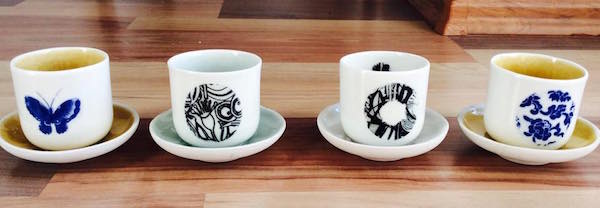
Seria Flüc – Floricia Calderon Lucio Campoli
A Berlino è tutta un’altra cosa
Oltre a tutte le informazioni sulla ceramica e sui suoi lavori, durante la mostra, non mi sono fatto sfuggire l’occasione di indagare e di domandare a Lucio le ragioni della sua scelta di vivere a Berlino. È così che mi ha spiegato che, pur non essendo l’unico motivo del suo trasferimento, quello professionale è stata una delle ragioni per la sua decisione.
Lucio mi ha detto che qui è più facile reperire materiali per le alte temperature (fondamentali per il suo lavoro), e che la ceramica è più conosciuta e utilizzata rispetto all’Italia, dove i luoghi di produzione sono ancora legati ai decori del ‘400. Ma la ragione fondamentale è che qui un artigiano può vivere più dignitosamente. E non è una questione soltanto economica, ma di mentalità. In Italia essere un artista spesso viene visto come un alibi per camuffare l’incapacità o la mancanza di voglia di fare, o si è ricchi e conosciuti, oppure si è tra i tanti che, pur dedicandosi con passione alla musica, alla pittura o a qualsiasi altra forma d’arte, sembrano non aver alcun tipo di riconoscimento e, talvolta, di rispetto. Qui è tutta un’altra cosa…
Com’era facile prevedere, la collezione Flüc ha riscosso il successo meritato andando del tutto esaurita e ora, a casa dei miei genitori a Napoli, oltre alle porcellane di Capodimonte, è possibile ammirare anche le creazioni di porcellana di Lucio Campoli.
